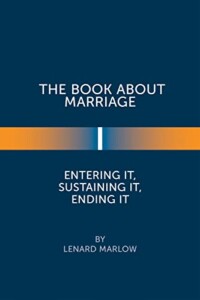Title: The Book About Marriage
Author: Lenard Marlow
Publisher: XlibrisUS
ISBN: 978-1-6641-6011-8
Pages: 178
Genre: Legal
Reviewed by: Margie Przybylski
Pacific Book Review
Ironically, Lenard Marlow’s book titled The Book About Marriage is largely concerned with why so many marriages end in divorce. The divorce lawyer of two other books on the topic of ending a marriage thoroughly explains what he sees before his very eyes in his office. Marlow states the facts about the nature of humans and their relationships, and how our nature allows us to fall in love and then eventually out of it. How two people who were once in complete awe of each other can turn into each other’s worst enemy.
Marlow explains that this book is less for people who want to get divorced and more for people who want to stay married. I hope and pray the readers who find this book learn enough about themselves while reading and are able to work out their marriage with their spouse. I believe if they have hope for their marriage and are turning to books about marriage to salvage their relationship – this book can help. Marlow paints an ugly picture of divorce agreements and how gruesome they can be.
The lawyer also recommended young people read this book if they are in a serious relationship that may lead to marriage. He explains how to know whether they should continue the relationship or not. In short – if you do not want to be with someone’s problems for the rest of their life – do not marry them. I agree this is great advice but even Marlow recognizes that most young people in relationships do not see any problems in their partner. He even goes so far as to say that people despise their spouse for the same reason they fell in love with them.
While The first and largest portion of the book concerns the decision to get married, the second part can help repair what can be a marriage in shambles. He discusses some popular approaches to marriage counseling before discussing his own road map to repairing a marriage. This book can serve as a companion to someone who feels lost in their marriage’s struggles. From the beginning Marlow works with the reader to determine the type of marriage that would suit their needs, and how to work that out with their partner.
Unfortunately, Marlow believes not all marriages can be saved. The book’s last chapter covers divorce and how the process works. For a reader in the position of going through a divorce I think this book is helpful. I can’t imagine it is a lonely and terrifying journey to get divorced and a book like Marlow’s can be hard to find. For readers that need this book I hope they find the answers they are looking for and perhaps are able to work out their relationship without getting divorced.


